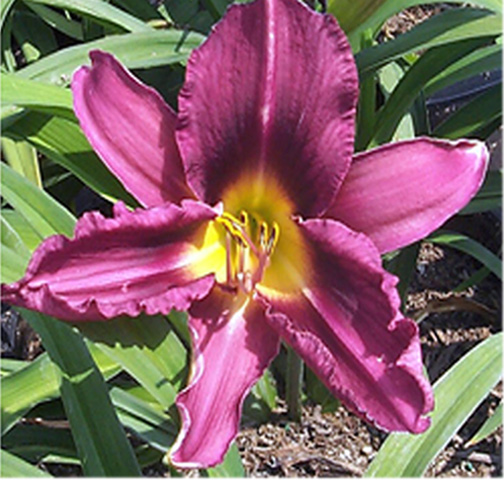| Botanical Name: Hemerocallis 'Russian Rhapsody' | |
| Common Name: Russian Rhapsody Daylily |

-
Anatomy
-
Culture
-
Design
Plant Type
Ground cover, Perennial
Height Range
1-3'
Flower Color
Violet
Flower Season
Summer
Leaf Color
Green
Bark Color
n/a
Fruit Color
n/a
Fruit Season
n/a
Sun
Full, Half
Water
Low, Medium
Growth Rate
Moderate
Soil Type
Sandy, Clay, Loam, Rocky, Unparticular
Soil Condition
Average, Rich, Poor, Well-drained, Dry
Soil pH
Acid, Neutral, Basic
Adverse Factors
n/a
Design Styles
English Cottage, Formal, Japanese, Mediterranean, Ranch, Spanish
Accenting Features
Showy Flowers, Unusual Foliage
Seasonal Interest
Summer, Fall
Location Uses
Entry, Perennial Border, Shrub Border, Foundation, Patio, Parking Lot, Raised Planter, Walkways
Special Uses
Container, Erosion Control, Mass Planting, Naturalizing, Small Spaces
Attracts Wildlife
Hummingbirds, Butterflies
Information by: Stephanie Duer
Photographer:
Photographer:
-
Description
-
Notes
'Russian Rhapsody' has violet flowers with a slight yellow-green throat. It is a mid-season bloomer, and repeats bloom. Grows about 20 inches tall. All daylilies have grass-like, green foliage that grows in clumps; fall color is yellow. Use at the front of shrub or foundation borders, in perennial gardens, or along paths. They are also great for those areas that get little care, such as the sides of garages, along the alley or driveway.
Grow in well drained soil in full sun to a little shade. The ideal soil is a loam-sand or clay-loam soil, though daylilies are very adaptive. Avoid overhead watering, as that can cause spots on the flowers, or cause them to wilt. As flowers along the scape are spent, you can break them off to keep a tidier appearance, or simply remove the entire scape after flowering is completed. Remove old foliage and any remaining scapes in late winter to early spring, as new foliage emerges. Very heat tolerant. Though moderately drought tolerant, adequate watering during the spring when buds are forming is essential to vigorous summer flowering. Daylilies are discribed as being early-, mid-, or late bloomers and refers to when they bloom compared to other daylilies. Generally, daylily season is June through August, so early is usually around June, mid is July, and late is August. 'Rebloomers' usually have a primery bloom, followed by intermittant blooming the remainder of the season.